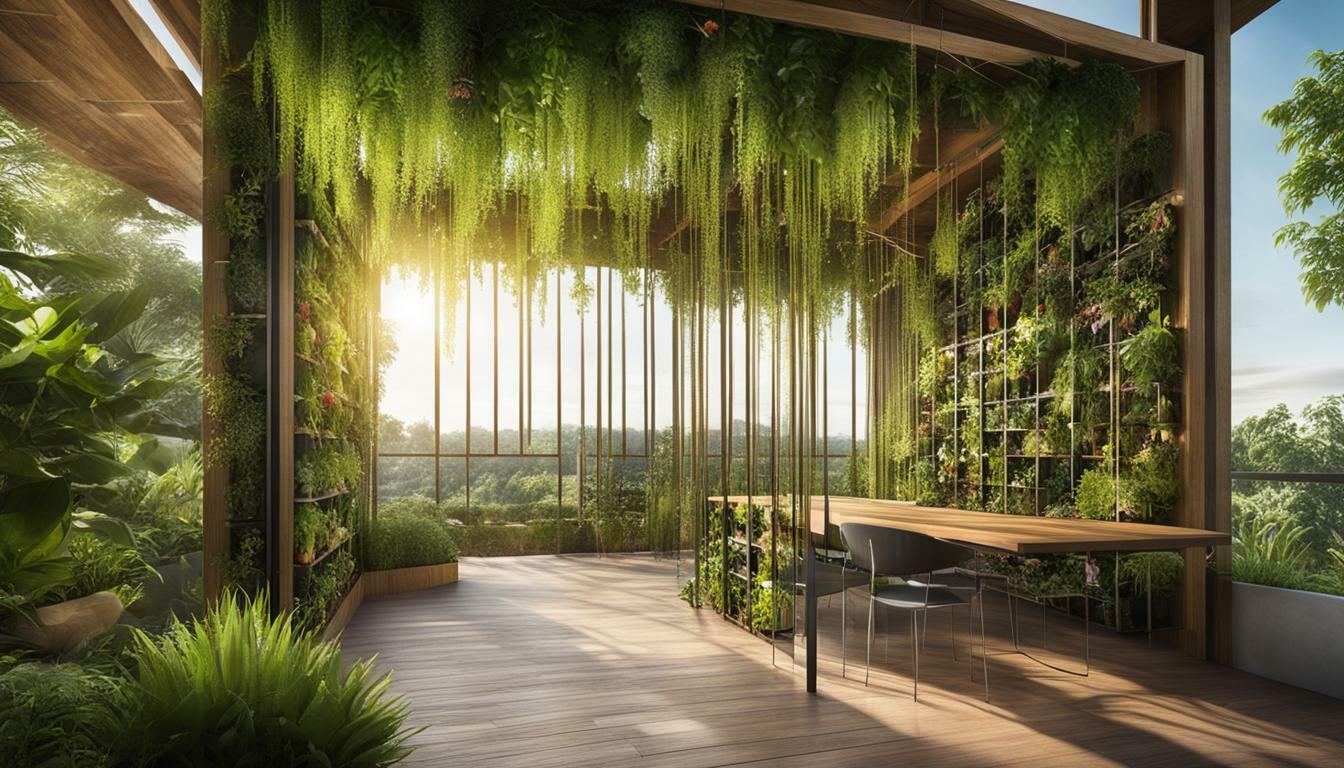Are you looking to make the most of your limited gardening space? Discover the potential of vertical vegetable gardening with our complete guide. Vertical gardening is a space-saving solution that allows you to grow plants upward, making use of walls, trellises, and other vertical structures. Whether you have a small balcony, a tiny backyard, or even just a window ledge, vertical vegetable gardening can help you maximize your growing area and enjoy a bountiful harvest.
Key Takeaways:
- Vertical vegetable gardening is a space-saving solution for small gardening areas.
- By utilizing vertical structures, such as trellises and walls, you can grow more plants in a smaller space.
- Vertical gardening offers numerous benefits, including increased yields, reduced plant problems, better air circulation, and easier maintenance.
- Choosing the right plants for vertical gardening is crucial. Vining, rambling, and sprawling varieties are best suited for vertical growth.
- There are various types of vertical gardening structures available, including trellises, tripods, arches, and pergolas, each suited for different plant characteristics.
- DIY vertical gardening ideas can inspire you to create your own vertical garden using creative and practical techniques.
- The best vegetables for vertical gardening include pole beans, climbing peas, vining tomatoes, and sprawling varieties of zucchini, cucumber, melon, and squash.
- Vertical vegetable gardening is a great solution for urban gardening and maximizing space in small areas.
Vertical vegetable gardening is a game-changer for small-space gardening enthusiasts. With the right design, plants can grow upward, making use of vertical structures and maximizing your growing area. In the following sections, we will explore the benefits of vertical gardening, provide practical tips for building trellises and supports, discuss the best plants for vertical gardening, and present creative DIY ideas for your own vertical garden. Get ready to unleash the full potential of your limited gardening space!
Grow Up! Benefits of Vertical Gardening
Gardening in all three dimensions by using vertical structures offers several benefits for small spaces and urban areas. Whether you have limited outdoor space or want to maximize your garden’s potential, vertical gardening allows you to grow more plants in less space.
One of the primary benefits of vertical gardening is increased yields. By utilizing vertical space, you can grow more plants and maximize your harvest. The vertical planting also makes maintenance and harvesting easier, as plants are elevated, reducing the need for bending and kneeling.
Vertical gardening also helps reduce plant problems. By lifting foliage and fruit off the ground, plants are less susceptible to diseases that thrive in moist and crowded conditions. Improved air circulation in vertical gardens allows plants to dry faster after watering, reducing the risk of fungal diseases like powdery mildew and rust.
Furthermore, vertical gardening exposes more leaf surface to sunlight, promoting healthier growth. Plants that aren’t sprawling on the ground have better access to sunlight, which is essential for photosynthesis and optimum plant development.
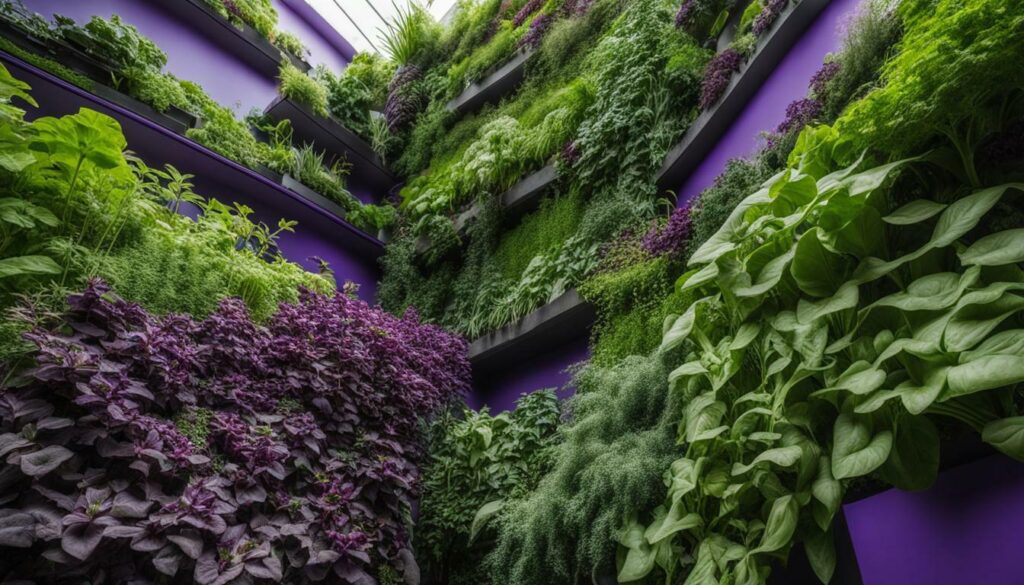
Lastly, vertical gardening is easier on your back. You can tend to your plants and harvest while standing, reducing strain on your knees and back. This makes gardening more enjoyable and accessible for people of all ages and physical abilities.
Watering Considerations
While vertical gardens offer numerous benefits, it is important to note that they may require more frequent watering. Wall-mounted planters, in particular, may need regular watering due to the rain shadow cast by the wall. Consider implementing micro or drip irrigation systems, which deliver water efficiently and can be coupled with timers for automated watering.
Conclusion
Vertical gardening is a practical and efficient solution for maximizing space in small gardens and urban areas. It offers increased yields, reduced plant problems, better air circulation, and easier maintenance. By choosing the right plants, constructing suitable structures, and implementing proper watering techniques, you can create a beautiful and productive vertical garden.
Building Trellises and Supports for Climbing Vegetables
Learn how to construct trellises and supports to create a sturdy framework for your climbing vegetables. Vertical gardening allows you to make the most of your space by utilizing upward growth and maximizing your garden’s potential. By providing a structure for your plants to climb, you can effectively grow more vegetables in a smaller area.
One simple and cost-effective way to build a trellis is by using wooden prunings. Prunings from woody plants can be cut into suitable lengths and then arranged in a ladder-like pattern to create a trellis. Secure the prunings together with wire or twine, ensuring that the structure is stable and able to support the weight of the climbing vegetables. This DIY trellis is perfect for vining plants like cucumbers, beans, and peas.
For sturdier and larger plants, such as grapevines, an arch or pergola may be more suitable. These structures provide a strong base for the plants to climb and can create a beautiful focal point in your garden. When building an arch or pergola, ensure that it is securely anchored and able to withstand the weight of the mature plants. You can use materials like metal, wood, or bamboo to construct these structures, depending on your preference and the aesthetic you want to achieve.
Example Table:
| Vegetable | Variety | Support |
|---|---|---|
| Cucumbers | Marketmore | Trellis |
| Beans | Blue Lake | Teepee |
| Peas | Sugar Snap | Trellis |
Remember to choose the right support structure based on the characteristics of your plants. Leafy plants with tendrils, such as pole beans and sweet peas, do well on trellises. Heavier plants, like grapevines, may require more substantial structures like arches or pergolas. Ensuring that your supports are appropriate for the growth habit and weight of your plants will help them thrive and maximize your vertical gardening space.
Urban Gardening: Cram More Into a Small Vegetable Garden!
Urban gardening opens up a world of possibilities for growing vegetables in limited space. Discover how to make the most of your small urban garden. With the increasing popularity of container gardening and vertical gardening, even the smallest urban spaces can become productive vegetable gardens.
Container gardening is a great way to grow vegetables in small areas such as balconies, patios, or windowsills. You can use pots, hanging baskets, or even repurposed containers to grow a variety of vegetables. Choose compact varieties that are suitable for container gardening, such as cherry tomatoes, lettuce, peppers, and herbs. Make sure the containers have good drainage and use a quality potting mix to ensure the plants have the nutrients they need to thrive.
Vertical gardening is another excellent option for maximizing space in small urban gardens. By growing plants vertically on trellises, fences, or walls, you can make the most of the available space. Vining vegetables like cucumbers, beans, and peas are ideal for vertical gardening. They can climb up trellises or supports, freeing up ground space for other plants. You can also use hanging planters or wall-mounted systems to create a living wall of herbs or salad greens.
Utilizing Vertical Space with a DIY Trellis
If you have a small garden plot, consider adding a DIY trellis to maximize vertical space. You can easily build a trellis using simple materials like wooden stakes and chicken wire. Carefully anchor the stakes into the ground, ensuring they are sturdy enough to support the weight of the plants. Attach the chicken wire to the stakes, creating a framework for the plants to climb. Then, plant your vining vegetables at the base of the trellis and guide them up as they grow.
Not only does vertical gardening help you grow more vegetables in limited space, but it also has other advantages. By training plants to grow vertically, you can improve air circulation, reduce plant diseases, and make harvesting easier. Additionally, vertical gardening can create an aesthetically pleasing display in your urban garden.
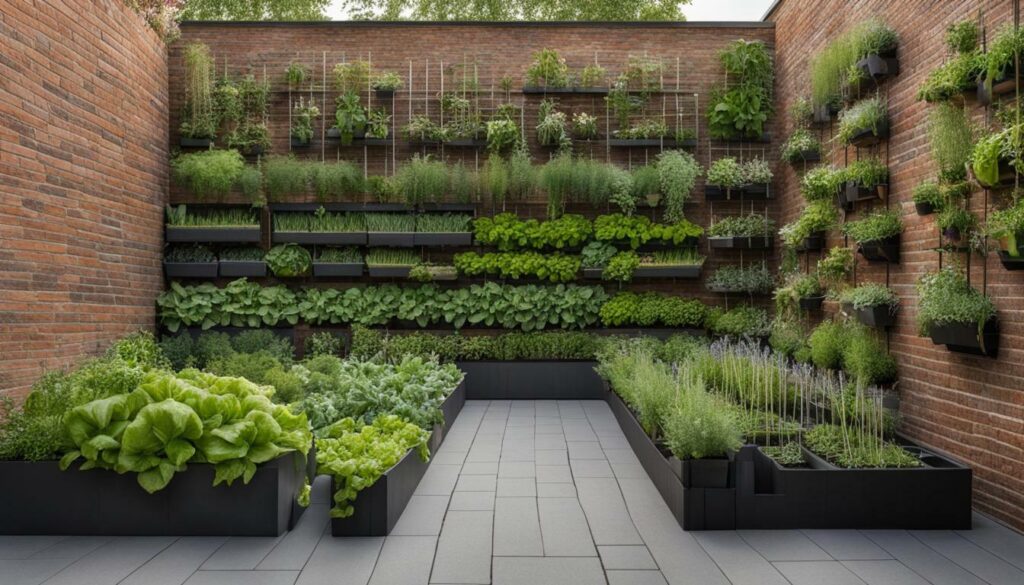
| Vegetable | Best for Vertical Gardening |
|---|---|
| Pole Beans | Perfect for climbing up trellises or supports |
| Peas | Can be trained to grow vertically with the help of trellises |
| Cucumbers | Can be grown vertically on trellises or in hanging planters |
| Tomatoes | Vining varieties can be trained to grow up trellises or stakes |
Vertical gardening is a practical and effective way to maximize space in small urban gardens. Whether you choose container gardening or vertical gardening, you can enjoy the benefits of growing your own vegetables even in limited space. Plus, the sight of lush green plants climbing up trellises or hanging from walls can add beauty and charm to your urban garden.
Which Plants Are Best for Vertical Gardening?
Choosing the right plants is crucial for successful vertical gardening. Explore the best vegetable varieties that thrive in vertical growing conditions.
When it comes to vertical gardening, vining, rambling, and sprawling plants are the ideal choices. These plants can be easily trained to grow up and off the ground, making them perfect for maximizing space in small gardens. Unlike bush-type species, vining varieties take up less horizontal space on the ground while still yielding a plentiful harvest.
It’s important to keep in mind that all vegetables need 6 to 8 hours of direct sunlight, so select a surface that faces the midday or afternoon sun to ensure optimal growth. The plants exposed to more sunlight will benefit from increased leaf surface area and promote healthier growth.
Some of the best vegetables for vertical gardening include pole beans, climbing peas, vining tomatoes, and sprawling varieties of zucchini, cucumber, melon, and squash. These plants can be easily trained to grow up trellises or supports, saving valuable ground space and allowing for higher yields.
Best Vertical Garden Plants:
| Vegetable | Varieties |
|---|---|
| Cherry Tomato | ‘Sungold’, ‘Black Cherry’, ‘Gardener’s Delight’, ‘Blondkopfchen’ |
| Cucumber | ‘Burpee Hybrid II’, ‘County Fair 83’, ‘Dasher 11’, ‘Saladin’ |
| Green Bean | ‘Romano Italian’, ‘Meraviglia Venezia’, ‘Gold of Bacau’ |
| Lima Bean | ‘Doctor Martin’, ‘King of the Garden’ |
| Melon | ‘Delicious 51’, ‘Tigger’, ‘Sleeping Beauty’ (musk melon); ‘White Wonder’, ‘Yellow Doll’ (watermelon) |
| Pea | ‘Dual’, ‘Garden Sweet’, ‘Maestro’, ‘Sugar Snap’, ‘Super Sugar Snap’ |
| Squash | Acorn, Delicata, Yellow Summer, Zucchini |
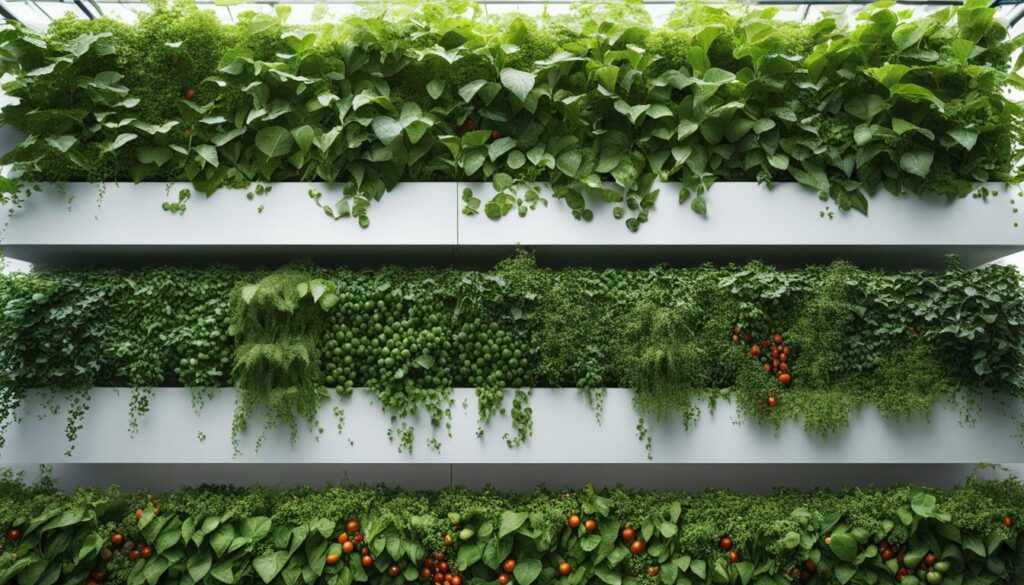
By choosing the right plants for vertical gardening, you can make the most of your small space while still enjoying a bountiful harvest. Whether you opt for trellises, tripods, or other vertical structures, these plants will thrive and provide you with fresh and delicious produce. So get started on your vertical garden and enjoy the benefits of maximizing your space in an urban or small garden setting.
Types of Vertical Gardening Structures
Discover the wide range of vertical gardening structures available and learn how to choose the right one for your garden. Vertical gardening structures allow you to make the most of your space by utilizing the vertical dimension to grow plants. From trellises and tripods to arches and pergolas, there are various options to suit different plant types and garden styles.
Trellises
Trellises are a popular choice for vertical gardening, especially for plants with tendrils like pole beans and sweet peas. They can be bought or easily made from woody pruning. Trellises are ideal for leafy plants that need support and can climb upwards. Make sure the trellis is well-anchored and able to accommodate the weight of mature plants.
Arches and Pergolas
For more substantial plants like grapevines, arches and pergolas provide a sturdier structure. These can be used to train fruit trees such as apples, pears, and cherries against a wall or fence. Fruit trees can be trained into different shapes, such as espaliers or fan shapes, using horizontal wires for support. Ensure that the structure is securely anchored and can withstand the weight of the plants.
Other Structures
In addition to trellises and arches, there are other vertical gardening structures to consider. Wire cages, netting, and bamboo poles can be used to support climbing plants. Gazebos and wall-mounted planters are also options for vertical gardening. Choose the structure that best matches the growth habits of your chosen plants and fits the style of your garden.
| Plant | Recommended Varieties |
|---|---|
| Cherry Tomato | ‘Sungold’, ‘Black Cherry’, ‘Gardener’s Delight’, ‘Blondkopfchen’ |
| Cucumber | ‘Burpee Hybrid II’, ‘County Fair 83’, ‘Dasher 11’, ‘Saladin’ |
| Green Bean | ‘Romano Italian’, ‘Meraviglia Venezia’, ‘Gold of Bacau’ |
| Lima Bean | ‘Doctor Martin’, ‘King of the Garden’ |
| Melon | ‘Delicious 51’, ‘Tigger’, ‘Sleeping Beauty’ (musk melon); ‘White Wonder’, ‘Yellow Doll’ (watermelon) |
| Pea | ‘Dual’, ‘Garden Sweet’, ‘Maestro’, ‘Sugar Snap’, ‘Super Sugar Snap’ |
| Squash | acorn, delicata, yellow summer, zucchini |
These plants are well-suited for vertical gardening and can be trained to grow up supports, maximizing the use of space in your garden. Consider their growth habits, sunlight requirements, and your available space when choosing what to plant in your vertical garden.
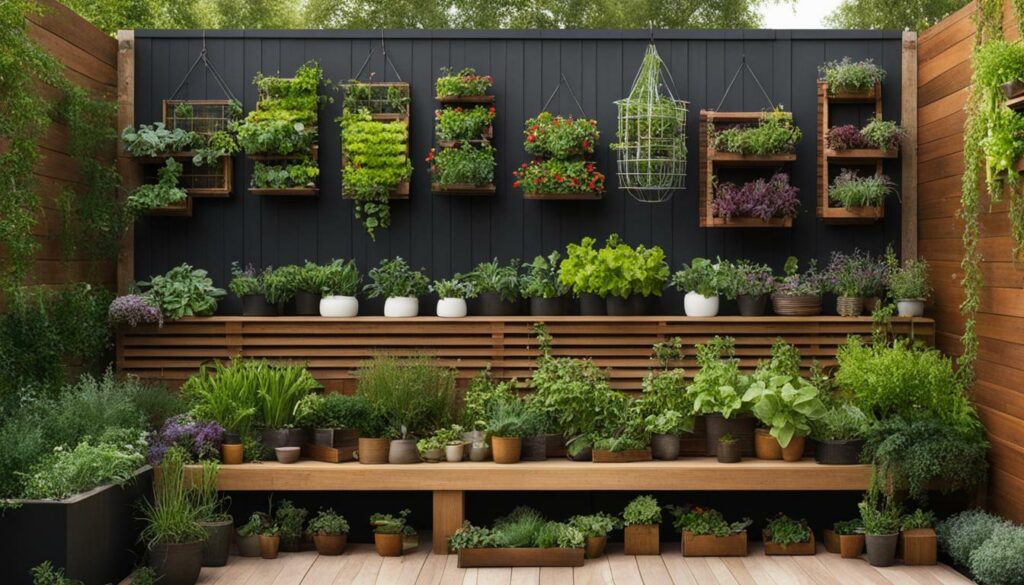
With the right vertical gardening structure, you can create a visually appealing and productive garden even in limited space. Whether it’s a trellis, arch, or pergola, choose a structure that complements your garden style and supports the growth habits of your chosen plants. Vertical gardening allows you to make the most of your space while adding beauty and functionality to your garden.
DIY Vertical Gardening Ideas
Get inspired by these DIY vertical gardening ideas that will transform your small space into a beautiful and productive garden. With limited space, you can still enjoy the benefits of growing your own vegetables and herbs by utilizing vertical structures and containers.
One easy way to make a vertical garden in an attractive way is to create a living wall. Start by securing a trellis panel onto the wall and use a range of pots to plant herbs, vegetables, and flowers. Choose a suitable-sized panel and give it a coat of wood stain or paint to protect it and make it stand out. Hang the panel on the wall using sturdy hooks, making sure they are level and evenly spaced. Plant low-growing crops like lettuce, pea shoots, bush beans, and herbs in the pots, spacing them out evenly and securing them to the trellis with sturdy twine. Regularly water the plants and harvest as needed.
Another creative DIY idea is to make a vegetable arch using galvanized metal uprights and cattle panels. Clad the arch with climbing crops like beans, cucumbers, and squash. Dig planting trenches on either side of the arch and drive home the uprights, backfilling the trenches with nutrient-rich organic matter and soil. Cut the cattle panels to size and secure them to the posts with zip ties. Plant your climbing vegetables in the trenches and add a layer of organic matter once they are established. Most plants should find their own way up, but gently weave them into place if needed.
| Vegetable | Recommended Varieties |
|---|---|
| Tomato | ‘Sungold’, ‘Black Cherry’, ‘Gardener’s Delight’, ‘Blondkopfchen’ |
| Cucumber | ‘Burpee Hybrid II’, ‘County Fair 83’, ‘Dasher 11’, ‘Saladin’ |
| Green Bean | ‘Romano Italian’, ‘Meraviglia Venezia’, ‘Gold of Bacau’ |
| Lima Bean | ‘Doctor Martin’, ‘King of the Garden’ |
| Melon | ‘Delicious 51’, ‘Tigger’, ‘Sleeping Beauty’ (musk melon); ‘White Wonder’, ‘Yellow Doll’ (watermelon) |
| Pea | ‘Dual’, ‘Garden Sweet’, ‘Maestro’, ‘Sugar Snap’, ‘Super Sugar Snap’ |
| Squash | acorn, delicata, yellow summer, zucchini |
When choosing plants for vertical gardening, consider selecting vining, rambling, and sprawling varieties that can be trained to grow up trellises and supports. These plants take up less horizontal space and allow you to make the most of your limited vertical space. Ensure your vertical garden receives 6 to 8 hours of direct sunlight, picking a surface that faces the midday or afternoon sun for optimal growth.
Remember to match the structure with the characteristics of the plants. Tendril plants like pole beans and sweet peas do well climbing up trellises, while more substantial plants like grapevines benefit from sturdier structures like arches or pergolas. Fruit trees such as apples, pears, and cherries can also be trained against walls or fences using wire supports. Use horizontal wires strained between fence posts to create the necessary supports for wall-trained fruit trees.
With these DIY vertical gardening ideas, you can transform your small space into a productive garden, maximizing your growing area and enjoying the benefits of growing your own food.
Best Vegetables for Vertical Gardening
Discover the top vegetable varieties that thrive when grown vertically and maximize your harvest in limited space.
Tomatoes
Tomatoes are a favorite among vertical gardeners due to their vining growth habit. They can be trained to climb up trellises, fences, or stakes, saving valuable ground space. Some recommended tomato varieties for vertical gardening include:
- Cherry tomato: ‘Sungold’, ‘Black Cherry’, ‘Gardener’s Delight’, ‘Blondkopfchen’
- Vining tomato: ‘Amish Paste Tomatoes’, ‘Lemon Boy’, ‘Jubilee’
Cucumbers
Cucumbers are another excellent choice for vertical gardening. They can be grown on trellises or in hanging baskets, allowing the vines to climb and freeing up ground space. Recommended cucumber varieties for vertical gardening include:
- Green cucumber: ‘Burpee Hybrid II’, ‘County Fair 83’, ‘Dasher 11’, ‘Saladin’
Beans
Beans are well-suited for vertical gardening, thanks to their climbing nature. Whether it’s pole beans or climbing peas, these vegetables can be trained to grow up trellises or stakes, maximizing space. Recommended bean varieties for vertical gardening include:
- Green bean: ‘Romano Italian’, ‘Meraviglia Venezia’, ‘Gold of Bacau’
- Lima bean: ‘Doctor Martin’, ‘King of the Garden’
- Pea: ‘Dual’, ‘Garden Sweet’, ‘Maestro’, ‘Sugar Snap’, ‘Super Sugar Snap’
Squash and Melons
Squash and melons can also be grown vertically, although they require sturdy supports due to their weight. Opt for sprawling varieties that can be trained up trellises or cages. Recommended varieties for vertical gardening include acorn squash, delicata squash, yellow summer squash, zucchini, and melons such as ‘Delicious 51’, ‘Tigger’, ‘Sleeping Beauty’ (musk melon), ‘White Wonder’, ‘Yellow Doll’ (watermelon).
Benefits of Vertical Gardening
“Vertical gardening is a great way to maximize your growing space. By training vegetables to grow up, you can not only save valuable ground space but also increase yields and reduce plant problems. It’s a win-win!”
| Vegetable | Recommended Varieties |
|---|---|
| Tomatoes | ‘Sungold’, ‘Black Cherry’, ‘Gardener’s Delight’, ‘Blondkopfchen’ |
| Cucumbers | ‘Burpee Hybrid II’, ‘County Fair 83’, ‘Dasher 11’, ‘Saladin’ |
| Beans | ‘Romano Italian’, ‘Meraviglia Venezia’, ‘Gold of Bacau’, ‘Doctor Martin’, ‘King of the Garden’ |
| Squash and Melons | Acorn squash, delicata squash, yellow summer squash, zucchini, ‘Delicious 51’, ‘Tigger’, ‘Sleeping Beauty’, ‘White Wonder’, ‘Yellow Doll’ |
Vertical gardening provides a practical solution for small space gardening, allowing you to grow a variety of vegetables even in limited areas. By choosing the right varieties and providing proper support, you can create a productive and space-efficient vertical garden. Start with these recommended vegetables and enjoy the benefits of vertical gardening!
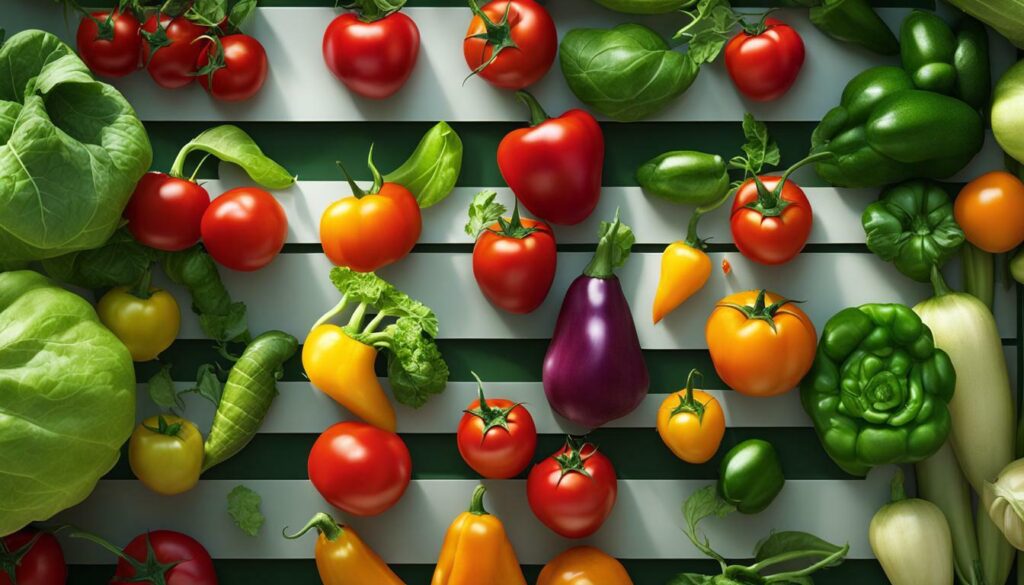
Conclusion
Vertical vegetable gardening is a game-changer for small space and urban gardening, offering endless possibilities for growing your own fresh produce in limited areas. By utilizing vertical space and employing trellises, supports, and other structures, you can maximize your gardening space and enjoy the benefits of increased yields, reduced plant problems, better air circulation, and easier maintenance.
When it comes to choosing the right plants for vertical gardening, opt for vining, rambling, and sprawling varieties that can be trained to grow up and off the ground. Pole beans, climbing peas, vining tomatoes, and sprawling varieties of zucchini, cucumber, melon, and squash are excellent choices for vertical gardens.
There are various types of vertical gardening structures to consider, such as trellises, tripods, arches, and pergolas. Select a structure that matches the characteristics of the plants you intend to grow, ensuring it can accommodate the weight of mature plants and is securely anchored.
If you’re feeling creative and want to take a hands-on approach, there are plenty of DIY vertical gardening ideas that you can explore. From creating a living wall using trellis panels to building a vegetable arch using galvanized metal uprights and cattle panels, the possibilities are endless for designing your own unique and productive vertical garden.
In conclusion, vertical vegetable gardening opens up a world of opportunities for maximizing space in small gardens and urban areas. With the right plants, structures, and techniques, you can enjoy the benefits of fresh homegrown produce, no matter the size of your available space.
What Are the Benefits of an Indoor Vertical Vegetable Garden Compared to an Outdoor Vertical Vegetable Garden?
An indoor vertical vegetable garden offers year-round cultivation opportunities, regardless of weather. It allows for convenient access to fresh produce and minimizes exposure to pests or external contaminants. Unlike outdoor vertical vegetable gardens, indoor setups are protected from fluctuations in temperature and sunlight, ensuring consistent growth and harvest.
FAQ
Q: What is vertical gardening?
A: Vertical gardening is a method of growing plants vertically, using structures like trellises, tripods, and arches, to maximize space in small gardens or urban areas.
Q: What are the benefits of vertical gardening?
A: Vertical gardening offers several benefits, including increased yields, reduced plant problems, better air circulation, and easier maintenance. It also allows for easier harvesting and saves space in small gardens.
Q: Which plants are best for vertical gardening?
A: Vining, rambling, and sprawling plants are best suited for vertical gardening. Pole beans, climbing peas, vining tomatoes, and certain types of zucchini, cucumber, melon, and squash are ideal choices.
Q: What types of structures can be used for vertical gardening?
A: Various structures can be used for vertical gardening, such as trellises, tripods, arches, pergolas, wire cages, netting, and bamboo poles. The choice of structure should depend on the plant’s characteristics and growth habit.
Q: What are some DIY vertical gardening ideas?
A: Some DIY vertical gardening ideas include creating a living wall using a trellis panel, making a vegetable arch using galvanized metal uprights and cattle panels, and using containers and hanging gardens to grow plants vertically.
Q: How can I maximize space in a small vegetable garden?
A: To maximize space in a small vegetable garden, you can use vertical gardening techniques, grow climbing vegetables on trellises, utilize container gardening, and plan the garden layout strategically.
Q: Can vertical gardens be implemented in urban areas?
A: Yes, vertical gardens are particularly suitable for urban areas where space is limited. They can be implemented on balconies, rooftops, walls, and other vertical surfaces to grow vegetables and herbs.
Q: What are the best practices for maintaining a vertical garden?
A: Regular watering is important for vertical gardens, as they can dry out more quickly. Using micro or drip irrigation systems with timers can help automate the watering process. Additionally, it’s important to choose the right soil mix and provide adequate sunlight for the plants.
Q: What are the advantages of container gardening?
A: Container gardening allows for growing plants in confined spaces, such as balconies or small yards. It provides flexibility in terms of plant selection, allows for easy mobility, and protects plants from unexpected weather conditions.
Q: Can vertical gardening be done indoors?
A: Yes, vertical gardening can be done indoors using various techniques like wall-mounted planters, hanging gardens, and vertical hydroponic systems. Indoor vertical gardens are a great way to bring greenery into small living spaces.

